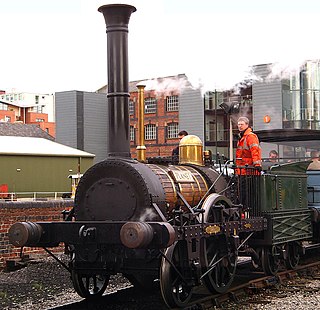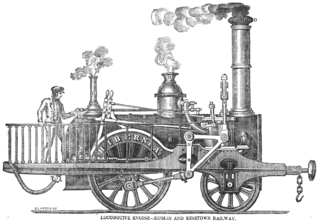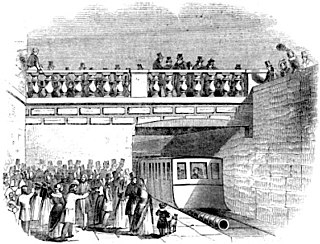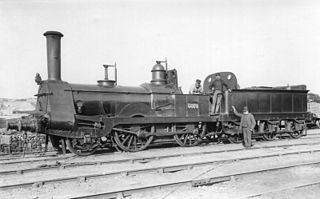
The Rainhill trials was an important competition run from the 6 to 14 October 1829, to test George Stephenson's argument that locomotives would have the best motive power for the then nearly-completed Liverpool and Manchester Railway (L&MR). Ten locomotives were entered, of which five were able to compete, running along a 1 mile (1.6 km) length of level track at Rainhill, in Lancashire.

Stephenson's Rocket is an early steam locomotive of 0-2-2 wheel arrangement. It was built for and won the Rainhill Trials of the Liverpool and Manchester Railway (L&MR), held in October 1829 to show that improved locomotives would be more efficient than stationary steam engines.

Under the Whyte notation for the classification of steam locomotives, 2-2-0 represents the wheel arrangement of two leading wheels on one axle, two powered driving wheels on one axle, and no trailing wheels. This configuration, which became very popular during the 1830s, was commonly called the Planet type after the first locomotive, Robert Stephenson's Planet of 1830.

The Dublin and South Eastern Railway (DSER), often referred to as the Slow and Easy, was an Irish gauge railway in Ireland from 1846 to 1925. It carried 4,626,226 passengers in 1911. It was the fourth largest railway operation in Ireland operating a main line from Dublin to Wexford, with branch lines to Shillelagh and Waterford. The company previously traded under the names Waterford, Wexford, Wicklow & Dublin Railway to 1848, Dublin and Wicklow Raillway (D&WR) to 1860 and Dublin, Wicklow and Wexford Railway (DW&WR) until 1906.

Novelty was an early steam locomotive built by John Ericsson and John Braithwaite to take part in the Rainhill Trials in 1829.

Sharp, Stewart and Company was a steam locomotive manufacturer, initially located in Manchester, England. The company was formed in 1843 upon the demise of Sharp, Roberts & Co.. It moved to Glasgow, Scotland, in 1888, eventually amalgamating with two other Glaswegian locomotive manufacturers to form the North British Locomotive Company.

Dún Laoghaire (Mallin) railway station is a station in Dún Laoghaire, Dún Laoghaire–Rathdown, Ireland.

The Dublin and Kingstown Railway (D&KR), which opened in 1834, was Ireland's first passenger railway. It linked Westland Row in Dublin with Kingstown Harbour in County Dublin.

The Dalkey Atmospheric Railway was an extension of the Dublin and Kingstown Railway (D&KR) to Atmospheric Road in Dalkey, County Dublin, Ireland. It used part of the Dalkey Quarry industrial tramway, which was earlier used for the construction of Kingstown Harbour. It was the first commercial railway of its type in the world.

Alexander Allan was a Scottish mechanical engineer. He was born at Montrose, Angus, in 1809 and died at Scarborough, Yorkshire on 2 June 1891.
George Forrester and Company was a British marine engine and locomotive manufacturer at Vauxhall Foundry in Liverpool, established by Scottish engineer George Forrester. The company opened in 1827 as iron founders and commenced building steam locomotives in 1834.

Experiment was a steam locomotive designed and built by Richard Roberts in 1833 for the Liverpool and Manchester Railway (L&MR). The locomotive had vertical cylinders driving via bell cranks.
The Dublin, Wicklow and Wexford Railway (DW&WR) Ariel Class refers to seven 2-2-2WT well tank locomotives built by Neilson and Company and introduced in 1865.
James Pim was the key person to the establishment and operation of the first passenger railway in Ireland, the Dublin and Kingstown Railway (D&KR), and the first commercial atmospheric railway in the world, the Dalkey Atmospheric Railway.

Swiftsure was first of eight or more similar locomotives with a single pair of driving wheels built by George Forrester and Company (Forresters) from 1834. The tank variant was the first passenger tank engine to enter service in the world.
Princess was the class lead for a set of five locomotives built by the Dublin and Kingstown Railway (D&KR) in their own Grand Canal Street works from 1841. Princess was both the first locomotive built in Ireland and the first locomotive to be completed by a railway company in the British Isles in their own workshops.
Star was a locomotive designed by Isaac Dodds of the 2-2-0 configuration and built in 1833 at the Horsley Coal & Iron Company, Tipton, Birmingham, England. Despite rebuilds it was never a successful engine and was scrapped in 1840.
Burgoyne was the class lead for a set of four locomotives built by the Dublin and Kingstown Railway (D&KR) in their own Grand Canal Street works from 1845.
William Fernihough was locomotive superintendent of the Eastern Counties Railway (ECR) from 1843 to 1845. He is noted for his work on the balancing of railway engines in particular the counterbalanced driving wheel
Thomas Fleming Bergin was an Irish civil engineer and early Irish railway official. He was the Company Clerk of the Dublin and Kingstown Railway (D&KR), the first public railway in Ireland. He was also responsible for the design of the Bergin Patent Spring Buffer, the buffering system that it used.












